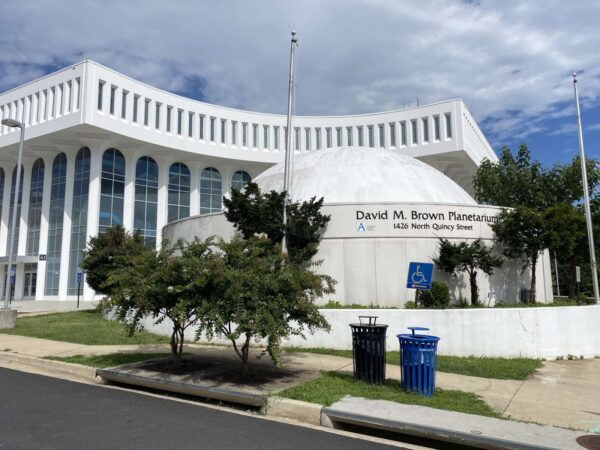
After being closed for nearly three years, the planetarium adjacent to Washington-Liberty High School is wishing upon a star that it will reopen later this fall.
It was back in November 2019 when the David M. Brown Planetarium on N. Quincy Street closed to allow for the overhaul of the adjacent Arlington Education Center at Washington-Liberty. It took longer than expected due to the pandemic, but that $38 million project is basically complete.
With that done, the planetarium is reopening as well with a few notable changes including a new person in charge, a state-of-the-art projector, and the removal of a mural.
The aim is to start running programs again by early November, Friends of Arlington’s Planetarium President Jennifer Lynn Bartlett told ARLnow.
The non-profit is the “booster club” for the planetarium, as Bartlett described it, while APS owns the facility and provides a large chunk of its funding.
While staff and students all missed the planetarium, the three-year closure and the adjacent building’s makeover allowed for much-needed updates, as well as staffing changes.
Earlier this summer, Arlington Public Schools hired Mary Clendenning as the school system’s new full-time planetarium specialist. For those who were regulars at the planetarium, she may be familiar, having presented weekend programming for several years prior to the closing. She also has more than two decades of experience in the classroom teaching science.
“I am thrilled to be Arlington’s new Planetarium Specialist!” she wrote in August’s Friends of Planetarium newsletter. “This new position offers me the opportunity to combine my passions while using a state-of-the-art projection system, the Digistar 7. I am so excited about being part of the reopening of an Arlington treasure, the Planetarium.”
The new projector system that Clendenning mentioned is set to be the star of the show.
When the planetarium first opened more than five decades ago, it had a mechanical optical system — essentially a ball that projected stars, ran patterns of the night sky, and faded lights to simulate the sun’s journey.
Then, in 2012, a new digital system replaced the old one. But like any computer, a system that’s a decade old is out of date.
“The technology is changing so rapidly that to continue to offer state-of-the-art programming, we need to move to more current hardware,” said Bartlett. “We want to continue to offer programs that are being written now about science that’s happening now.”
The new Digistar 7 system cost $209,000, which came from a combination of carry-over funds from last year’s APS budget and Friends-funded contributions.
Bartlett said the new projection system will allow educators to put on programs beyond astronomy, including lessons on oceanography, earth science, and biology.
The new projection system, like nearly all tech these days, needs an internet connection so the planetarium now has Wi-Fi.
Another thing that planetarium goers will notice when they visit later this year is a missing mural.
In the process of connecting some ductwork to the HVAC system of the newly-renovated W-L annex, it was discovered that the exterior shell of the planetarium and portions of the interior entrance hallway contained asbestos. APS decided to remove the asbestos inside and, because of that, it required the removal of a mural that featured planets, the Milky Way solar system, and other galactic images that Bartlett believed were painted sometime in the 1980s.
While a bit of disappointment, it does open up wall space that could be used as an extension of the planetarium’s mission.
“That could involve replacing the artwork with something similar or something that is more up-to-date in terms of our understanding of space,” said Bartlett. “It could also involve electronic signage where we could get programs like NASA’s View Space or have announcements.”
Currently, the wall is painted in a gradation of color to help visitors transition from light to dark when entering. Discussion of what to do next will begin after the planetarium reopens to the public, said Bartlett.
The planetarium first opened in 1969 and was renamed in 2008 after Yorktown High graduate and astronaut David M. Brown, who died in the 2003 Space Shuttle Columbia explosion. It nearly closed for good back in 2010 when APS faced a budget crisis. However, it was saved by $435,000 in contributions from then-newly-formed Friends of Arlington’s Planetarium and others.
Bartlett, who also teaches at the Naval Academy in Annapolis, said that Arlington’s planetarium has always been a powerful tool that helps students get excited about the sky above.
With these latest upgrades, the hope is that the planetarium will be around for generations to come.
“I think my son was only two when I took him to his first show [at the planetarium], and he was just completely absorbed,” she said. “We are very excited to be back under the dome, to welcome our whole community, and to know our students will continue to have this very immersive experience. We hope that this will enable them to better engage with science in the classroom.”

